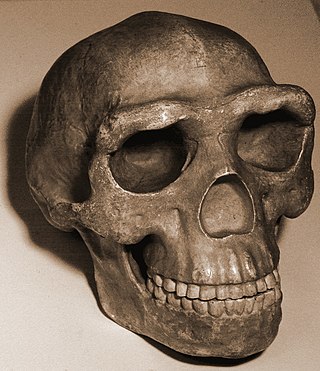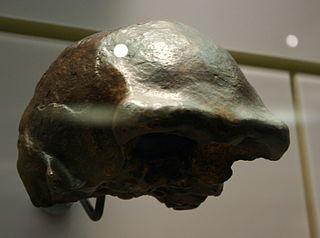
Davidson Black, FRS was a Canadian paleoanthropologist, best known for his naming of Sinanthropus pekinensis. He was Chairman of the Geological Survey of China and a Fellow of the Royal Society. He was known as 步達生 in China.

Peking Man is a subspecies of H. erectus which inhabited the Zhoukoudian cave site in modern northern China during the Chibanian. The first fossil, a tooth, was discovered in 1921, and the Zhoukoudian Cave has since then become the most productive H. erectus site in the world. Peking Man was instrumental in the foundation of Chinese anthropology, and fostered an important dialogue between Western and Eastern science for decades to come. The fossils became the centre of anthropological discussion, and were classified as a direct human ancestor, propping up the Out of Asia hypothesis that humans evolved in Asia. Peking Man also played a vital role in the restructuring of the Chinese identity following the Chinese Communist Revolution, and was intensively communicated to working class and peasant communities to introduce them to Marxism and science. Early models of Peking Man society strongly leaned towards communist or nationalist ideals, leading to discussions on primitive communism and polygenism. This produced a strong schism between Western and Eastern interpretations, especially as the West adopted the Out of Africa hypothesis by late 1967, and Peking Man's role in human evolution diminished as merely an offshoot of the human line. Though Out of Africa is now the consensus, Peking Man interbreeding with human ancestors is frequently discussed especially in Chinese circles.

Meganthropus is an extinct genus of non-hominin hominid ape, known from the Pleistocene of Indonesia. It is known from a series of large jaw and skull fragments found at the Sangiran site near Surakarta in Central Java, Indonesia, alongside several isolated teeth. The genus has a long and convoluted taxonomic history. The original fossils were ascribed to a new species, Meganthropus palaeojavanicus, and for a long time was considered invalid, with the genus name being used as an informal name for the fossils.

Solo Man is a subspecies of H. erectus that lived along the Solo River in Java, Indonesia, about 117,000 to 108,000 years ago in the Late Pleistocene. This population is the last known record of the species. It is known from 14 skullcaps, two tibiae, and a piece of the pelvis excavated near the village of Ngandong, and possibly three skulls from Sambungmacan and a skull from Ngawi depending on classification. The Ngandong site was first excavated from 1931 to 1933 under the direction of Willem Frederik Florus Oppenoorth, Carel ter Haar, and Gustav Heinrich Ralph von Koenigswald, but further study was set back by the Great Depression, World War II and the Indonesian War of Independence. In accordance with historical race concepts, Indonesian H. erectus subspecies were originally classified as the direct ancestors of Aboriginal Australians, but Solo Man is now thought to have no living descendants because the remains far predate modern human immigration into the area, which began roughly 55,000 to 50,000 years ago.

Homo is the genus that emerged from the genus Australopithecus and encompasses the extant species Homo sapiens and several extinct species classified as either ancestral to or closely related to modern humans, including Homo erectus and Homo neanderthalensis. The oldest member of the genus is Homo habilis, with records of just over 2 million years ago. Homo, together with the genus Paranthropus, is probably sister to Australopithecus africanus, which itself had split from the lineage of Pan, the chimpanzees.
Paleoanthropology or paleo-anthropology is a branch of paleontology and anthropology which seeks to understand the early development of anatomically modern humans, a process known as hominization, through the reconstruction of evolutionary kinship lines within the family Hominidae, working from biological evidence and cultural evidence.

Java Man is an early human fossil discovered in 1891 and 1892 on the island of Java. Estimated to be between 700,000 and 1,490,000 years old, it was, at the time of its discovery, the oldest hominid fossil ever found, and it remains the type specimen for Homo erectus.

Zhoukoudian Peking Man Site (周口店北京人遗址), also romanized as Choukoutien, is a cave system in suburban Fangshan District, Beijing. It has yielded many archaeological discoveries, including one of the first specimens of Homo erectus, dubbed Peking Man, and a fine assemblage of bones of the gigantic hyena Pachycrocuta brevirostris.

Gustav Heinrich Ralphvon Koenigswald was a German-Dutch paleontologist and geologist who conducted research on hominins, including Homo erectus. His discoveries and studies of hominid fossils in Java and his studies of other important fossils of south-eastern Asia firmly established his reputation as one of the leading figures of 20th-century paleo-anthropology.
Franz Weidenreich was a Jewish German anatomist and physical anthropologist who studied evolution.
Human taxonomy is the classification of the human species within zoological taxonomy. The systematic genus, Homo, is designed to include both anatomically modern humans and extinct varieties of archaic humans. Current humans have been designated as subspecies Homo sapiens sapiens, differentiated, according to some, from the direct ancestor, Homo sapiens idaltu.

Lantian Man, Homo erectus lantianensis) is a subspecies of Homo erectus known from an almost complete mandible from Chenchiawo (陈家窝) Village discovered in 1963, and a partial skull from Gongwangling (公王岭) Village discovered in 1964, situated in Lantian County on the Loess Plateau. The former dates to about 710–684 thousand years ago, and the latter 1.65–1.59 million years ago. This makes Lantian Man the second-oldest firmly dated H. erectus beyond Africa, and the oldest in East Asia. The fossils were first described by Woo Ju-Kan in 1964, who considered the subspecies an ancestor to Peking Man.

Yuanmou Man is a subspecies of H. erectus which inhabited the Yuanmou Basin in Yunnan Province, southwestern China, roughly 1.7 million years ago. It is the first fossil evidence of humans in China, though they probably reached the region by at least 2 million years ago. Yuanmou Man is known only from two upper first incisors presumed to have belonged to a male, and a partial tibia presumed to have belonged to a female. The female may have stood about 123.6–130.4 cm in life. These remains are anatomically quite similar to those contemporary early Homo in Africa, namely H. habilis and H. (e?) ergaster.

Wushan Man is a set of fossilised remains of an extinct, undetermined non-hominin ape found in central China in 1985. The remains are dated to around 2 million years ago and were originally considered to represent a subspecies of Homo erectus.

Nanjing Man is a specimen of Homo erectus found in China. Large fragments of one male and one female skull and a molar tooth of were discovered in 1993 in Hulu Cave on the Tangshan (汤山) hills in Jiangning District, Nanjing. The specimens were found in the Hulu limestone cave at a depth of 60–97 cm by Liu Luhong, a local worker. Dating the fossils yielded an estimated age of 580,000 to 620,000 years old.

Homo erectus is an extinct species of archaic human from the Pleistocene, with its earliest occurrence about 2 million years ago. Its specimens are among the first recognizable members of the genus Homo.

The Hominidae, whose members are known as the great apes or hominids, are a taxonomic family of primates that includes eight extant species in four genera: Pongo ; Gorilla ; Pan ; and Homo, of which only modern humans remain.

The terms Anthropopithecus and Pithecanthropus are obsolete taxa describing either chimpanzees or archaic humans. Both are derived from Greek ἄνθρωπος and πίθηκος, translating to "man-ape" and "ape-man", respectively.
Hu Chengzhi was a Chinese paleontologist and paleoanthropologist. He made the plaster casts of the Peking Man skull in the 1930s, and identified the Yuanmou Man based on fossils collected by others. He discovered the first fossil of Keichousaurus in 1957, and this species, K. hui, is named after him. A new hadrosaur discovered in Shandong is designated Shantungosaurusgiganteus by Hu in 1973.
The Narmada Human, originally the Narmada Man, is a species of extinct human that lived in central India during the Middle and Late Pleistocene. From a skull cup discovered from the bank of Narmada River in Madhya Pradesh in 1982, the discoverer, Arun Sonakia classified it was an archaic human and gave the name Narmada Man, with the scientific name H. erectus narmadensis. Analysis of additional fossils from the same location in 1997 indicated that the individual could be a female, hence, a revised name, Narmada Human, was introduced. It remains the oldest human species in India.
















